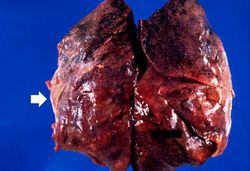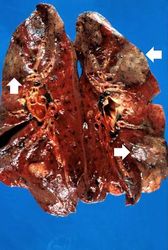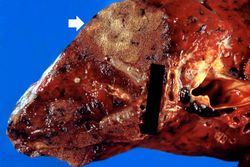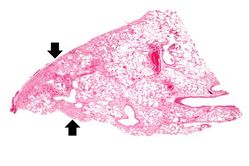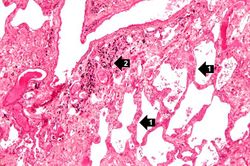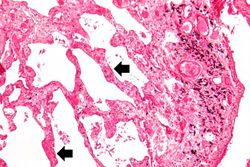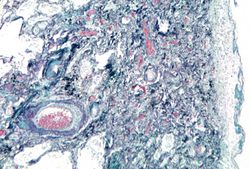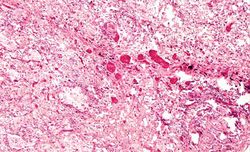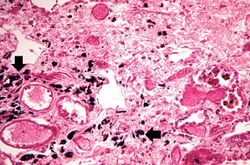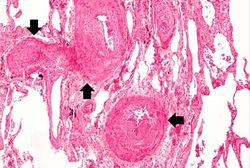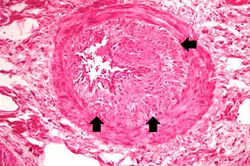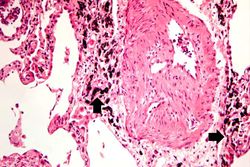|
|
| Line 3: |
Line 3: |
| | | | |
| | At autopsy there was metastatic carcinoma in the pericardium, chest wall, diaphragm, both lungs, and mediastinal lymph nodes. Areas of pleural thickening with adhesions and interstitial fibrosis were found involving the anterior aspect of both lungs. | | At autopsy there was metastatic carcinoma in the pericardium, chest wall, diaphragm, both lungs, and mediastinal lymph nodes. Areas of pleural thickening with adhesions and interstitial fibrosis were found involving the anterior aspect of both lungs. |
| − |
| |
| − | == Autopsy Findings ==
| |
| − |
| |
| − | There was metastatic carcinoma in the pericardium, chest wall, diaphragm, both lungs, and mediastinal lymph nodes. Severe nonobstructive cardiomyopathy, probably secondary to adriamycin, was found. Areas of pleural thickening with adhesions and interstitial fibrosis were found involving the anterior aspect of both lungs.
| |
| | | | |
| | == Images == | | == Images == |
Latest revision as of 21:12, 9 July 2020
Clinical Summary[edit]
This 56-year-old female was diagnosed with breast cancer and underwent a lumpectomy followed by radiation therapy. After 5 years without problems, the patient developed decreased exercise tolerance, dyspnea on exertion, shortness of breath, and an unintentional 15 pound weight loss. Recurrence of the breast cancer was identified but the patient opted for palliative therapy and subsequently expired at home.
At autopsy there was metastatic carcinoma in the pericardium, chest wall, diaphragm, both lungs, and mediastinal lymph nodes. Areas of pleural thickening with adhesions and interstitial fibrosis were found involving the anterior aspect of both lungs.
This is a gross photograph of lung demonstrating areas of fibrosis on the pleural surface (arrow).
This is a gross photograph of cut sections of lung. There are several areas of fibrosis (arrows) within the lung parenchyma.
This is a gross photograph showing a closer view of a cut section of lung. An area of fibrosis (arrow) is evident in this photograph.
This is a low-power photomicrograph of lung section. Note the thickening of the alveolar septa (arrows).
This is a higher-power photomicrograph of lung section. Note the thickening of the alveolar septa (1) and accumulations of anthracotic pigment (2).
This is another high-power photomicrograph of lung section showing the thickening of the alveolar septa (arrows) and accumulations of black anthracotic pigment.
This high-power photomicrograph of lung section shows the thickening of the alveolar septum (arrows) by fibrous connective tissue.
This is a photomicrograph of a trichrome-stained section of lung demonstrating the extensive fibrosis throughout this section (green-blue stained material is fibrous connective tissue).
This is a photomicrograph of an area of tissue exhibiting diffuse fibrosis and thickening of the alveolar septa.
This is another high-power photomicrograph of an area of tissue with diffuse fibrosis and thickening of the alveolar septa. There are also accumulations of anthracotic pigment in this area (arrows).
This medium-power photomicrograph shows fibrosis and severe intimal changes in blood vessels (arrows).
This high-power photomicrograph shows intimal changes (arrows) in this blood vessel in the lung.
This is a high-power photomicrograph of a recanalized blood vessel in the lung. Notice the anthracotic pigment adjacent to the vessel (arrows).
Virtual Microscopy[edit]
Study Questions[edit]
The lungs are extremely vascular; thus, the radiation changes seen in the vasculature can have a profound effect on the lungs. During the immediate post-irradiation period, endothelial cell swelling and vacuolization can be seen in the alveolar capillaries. The increased vascular permeability may lead to marked pulmonary congestion and edema and the other changes similar to those encountered in adult respiratory distress syndrome.
Long-term pulmonary consequences of radiation injury include fibrosis of the alveolar walls as well as the vascular changes seen in the previous case (vessel narrowing). The respiratory dysfunction due to the combined alveolar wall fibrosis and thickening as well as the poor perfusion due to the vascular lesions can severely inhibit pulmonary function. This radiation pneumonitis creates a profound alveolocapillary block.
Vascular changes, which are dose/rate dependent, are prominent in all irradiated tissues.
Endothelial cells are not specifically radiosensitive but with high exposure vascular changes can occur. There is endothelial swelling and vacuolation or even death of the endothelial cells which can then lead to secondary thrombosis or hemorrhage.
At later time points, intimal hyperplasia and fibrosis occurs which results in thickening of the vessel wall and narrowing of the vessel lumen. These vascular changes can lead to poor blood flow to the tissues.
Radiation can lead to alterations in the mitotic process resulting in cells that have abnormal mitotic figures. These changes can lead to death of the cell.
Subtle genetic injuries, such as DNA strand breaks, are responsible for translocations and deletions. These changes lead to the mutagenic, teratogenic, and carcinogenic potentials of ionizing radiation that become evident many years after the radiation exposure. During this long time interval, sequential mitotic divisions are occurring that will ultimately lead to these untoward consequences. This phenomenon is known as radiation "latency."
Additional Resources[edit]
Reference[edit]
Journal Articles[edit]
